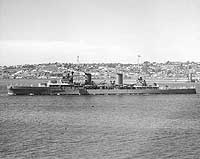
HMS Apollo, a 7105-ton light cruiser, was built at Devonport, England, the first of a class of three, all of which ultimately served in the Royal Australian Navy. Completed in January 1936, she operated on the North America and West Indies Stations until mid-1938. Transferred to Australia in late September 1938, she was then renamed HMAS Hobart and served in Australian waters during the remaining peacetime months.
Following the outbreak of war with Germany at the beginning of September 1939, Hobart cruised off Australia, in the East Indies and in the Indian Ocean to protect troop convoys en route to the war zone and to guard against the threat of enemy surface raiders. In April 1940 she went to the Red Sea, where she operated against Italian forces for several months. The cruiser served in the Mediterranean Sea during the last half of 1941, but was withdrawn when Japan began the Pacific War in December. She spent the rest of World War II in the Pacific. Her activities in 1942 included participation in the Battle of the Coral Sea in May and the invasion of Guadalcanal and Tulagi in August.
Hobart also operated extensively in the Coral Sea area, covering the Allies' vital south Pacific supply lines and protecting New Guinea from enemy surface threats. While steaming west of the New Hebrides on 20 July 1943, in company with the heavy cruiser Australia and three U.S. Navy destroyers, she was torpedoed by a Japanese submarine. Her after hull was seriously damaged, necessitating prolonged repairs at Sydney that kept her out of service until December 1944. During the rest of World War II, Hobart served in the Philippines and East Indies, taking part in amphibious landings at Cebu in March 1945 and Borneo in April-July. When Japan surrendered on 2 September 1945, she was part of the fleet anchored in Tokyo Bay to witness the event.
Following the end of hostilities Hobart participated in the occupation of Japan, a duty that continued on and off for two years. She was decommissioned in December 1947 and placed in reserve. In 1953, she began conversion and modernization to prepare her for service as the Royal Australian Navy's training cruiser. However, this mission was cancelled in 1956, and she was returned to reserve. HMAS Hobart was sold for scrapping in February 1962 and was subsequently broken up in Japan.
This page features, or provides links to, all the views we have related to HMAS Hobart and HMS Apollo.
For more images of HMS Hobart and HMS Apollo,
see:
| If you want higher resolution reproductions than the digital images presented here, see: "How to Obtain Photographic Reproductions." |
Click on the small photograph to prompt a larger view of the same image.
|
Photo #: NH 50342 HMS Apollo (British Light Cruiser, 1936) Underway off St. Johns, Virgin Islands, 2 February 1937. This ship later became HMAS Hobart. Note the high elevation of the 6-inch guns of "X" turret. U.S. Naval Historical Center Photograph. Online Image: 75KB; 740 x 620 pixels |
 |
|
Photo #: NH 58631 HMS Apollo (British Light Cruiser, 1936) At Charleston, South Carolina, circa 19-25 January 1938. This ship later became HMAS Hobart. U.S. Naval Historical Center Photograph. Online Image: 98KB; 740 x 540 pixels |
 |
|
Photo #: NH 58633 HMS Apollo (British Light Cruiser, 1936) At Miami, Florida, 1 February 1938. This ship later became HMAS Hobart. U.S. Naval Historical Center Photograph. Online Image: 64KB; 740 x 585 pixels |
 |
|
Photo #: NH 60599 HMAS Hobart (Australian Light Cruiser, 1936) In a harbor, circa 1938-1939. This ship had previously been HMS Apollo. U.S. Naval Historical Center Photograph. Online Image: 104KB; 740 x 615 pixels |
 |
|
Photo #: NH 60597 HMAS Hobart (Australian Light Cruiser, 1936) Underway, circa 1938-1939. This ship had previously been HMS Apollo. U.S. Naval Historical Center Photograph. Online Image: 84KB; 740 x 605 pixels |
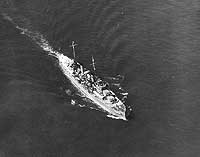 |
|
Photo #: NH 60598 HMAS Hobart (Australian Light Cruiser, 1936) Underway, circa 1938-1939. This ship had previously been HMS Apollo. U.S. Naval Historical Center Photograph. Online Image: 69KB; 570 x 765 pixels |
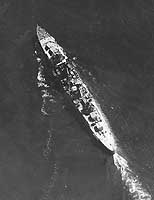 |
|
Photo #: 80-G-K-6304 (Color) HMAS Hobart (Australian Light Cruiser, 1936) Exercising with a U.S. and Australian cruiser force, off Subic Bay, Philippine Islands, circa August 1945. The ship beyond Hobart is either HMAS Australia or HMAS Shropshire. Official U.S. Navy Photograph, now in the collections of the National Archives. Online Image: 43KB; 740 x 610 pixels Reproductions of this image may also be available through the National Archives photographic reproduction system. |
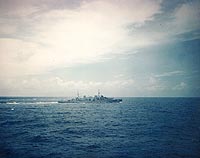 |
|
Photo #: 80-G-610149 HMAS Hobart (Australian Light Cruiser, 1936) In the harbor at Sydney, New South Wales, Australia, with the Harbor Bridge in the background, 20 March 1947. Photographed from the deck of USS Currituck (AV-7), as she was leaving Australia after a visit. Note whaleboat on davits in the right foreground. Official U.S. Navy Photograph, now in the collections of the National Archives. Online Image: 66KB; 740 x 610 pixels Reproductions of this image may also be available through the National Archives photographic reproduction system. |
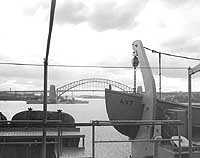 |
For more images of HMS Hobart and HMS Apollo,
see:
| If you want higher resolution reproductions than the digital images presented here, see: "How to Obtain Photographic Reproductions." |
Page made 3 May 2002